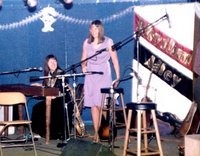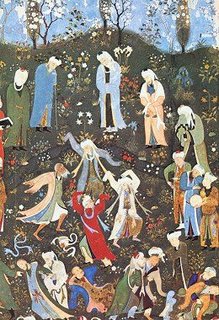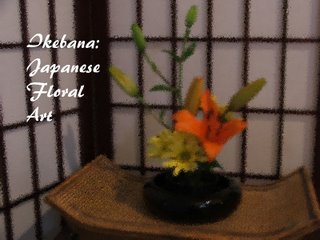scribbled in the margins
About Me
- Name: cafegirl
cafegirl is a working artist and graduate student with utterly appalling work habits and a very old laptop. This blog is specifically intended for graduate school writing assignments. If you have wandered in from my other blog, please note that I am blogging anonymously. Please remember that my classmates and professors read this - so play nicely. That being said, I DO encourage comments!!
Saturday, October 28, 2006
Thursday, October 26, 2006
Wednesday, October 25, 2006
Day of the Dead
We have a rather deep window sill on the landing of our stairs that serves as our home altar so I decided it was appropriate to use that space to honor my cousin, Jane, who died twenty years ago.
The bas relief is The Good Shepherd. There is also a tiny bas relief of a butterfly or moth that I used to signify the soul and resurrection. The silk leaves resemble the real ones in the trees beyond and are there because she died in November. Tucked in with the leaves are artist's brushes because she was an artist. She was also an anthropologist. The small book and the small, velvet bag belonged to her and contain things that were passed along to me. Also tucked inside are bits of memorabilia, like a recent invitation to her son's wedding. I chose that candleholder because she liked Art Nouveau. The chalice recalls the last time we shared a bottle of wine in my kitchen. That Egyptian-style illustration is of a scene from the Book of the Dead, in which the soul is weighed against Ma'at (Truth). It's there because Jane was the one that got me interested in archaeology - especially Egyptology - when we were kids.
Hallowe'en is a big deal in our household (although it pales in comparison to my sister-in-law's celebration!) My husband and I decorate the front of our house differently each year and we take turns planning the theme and presentation. In our neighborhood, adults go out in costume with their children and it becomes a kind of neighborhood-wide block party.
Inside our home, preparations are a lot simpler. I clean the house and put lights in the windows to make our home look welcoming. The table beside the front door is decorated and that is where we put the candy bowl. The idea behind these preparations is to extend hospitality to any wandering spirits that choose to visit. We usually eat while we wait for the doorbell to ring - light party snacks and such - and I think that reinforces the feeling that we are extending hospitality. Afterwards, my husband and I often go out for a late supper at a neighborhood restaurant where the staff is also very much in a holiday mood.
On the Day of the Dead, we often return to the same restaurant because the owner (who is from Arizona) and her staff set up a common altar at one end of the bar. It's always very festive and I find it sweet and touching that they share that with all of us.
In doing this exercise, it was easy to see that I don't really need a special day or altar to remember my cousin. There are reminders of her throughout my studio - even my writing desk was once hers. The fact is that our loved ones are always with us. We carry them in our hearts. They are part of us and help to make us who we are. The Day of the Dead is one way of celebrating that deep connection.
Thursday, October 12, 2006
Unit 5: Ireland
 Photo of a dolmen taken from Ken Williams' site, Shadow and Stone
Photo of a dolmen taken from Ken Williams' site, Shadow and StoneBlog prompts:
1) Write a personal response to each of the assigned fairytales (taken from Henry Glassie's Irish Folktales, (1985).
2) What do the tales tell you about the Irish view of space and time?
"Usheen's Return to Ireland": The last of the legendary Fenians, Usheen spends many years in Tir na nog, the land of eternal youth where the Tuatha De Danann had gone after departing mortal Ireland. When he desires to return to the mortal world, he is informed of the usual prohibition that safeguards his youth. In this case, he cannot let his feet touch the ground or the enchantment will end. Predictably, he cannot avoid touching the earth and the accumulated years overtake him.
The version of this tale in Glassie was collected by Lady Gregory. She provides a clue to anyone who would search for the location of the fairy realm: "But as to where Tir-Nan-Oge is, it is in every place, all about us."
In these Irish stories, we are given to understand that the realm of the other world co-exists with our own but it is not necessarily in the same space and time. We might say that it exists in a different dimension. It is, nonetheless, very real and tangible.
In the story "The Man Who Had No Story", a basketmaker named Brian encounters the fairy realm when he dares to go into an enchanted glen. Here, the fairy realm is the fictive realm - the land of story-tellers. He enters into the other world through his dreaming and, while he might start out knowing no fairytales or hero tales, he enters into these story realms and lives out his own adventures. At the end it is said that he never again cuts rods to weave baskets but I wonder if that is because he fears to return to the glen. Perhaps he has become a story-teller, now that he has some to tell!
The story of Usheen is part Fenian tale and part fairy tale. The story of "The Birth of Finn MacCumhail" is very much a Fenian tale (a sort of hero/tall tale), although there's plenty of magic, giants and a talking dog to keep things interesting! In this version, the legendary champion is not the only one who possesses extraordinary physical powers. Finn's grandmother also has them and she uses them to save her grandson.
As we've already seen, dreams are one of the portals through which the other realm can be encountered. The dream state is very real, in these folktales. The story "Dreams of Gold" is about this truth in dreams. Another tale collected by Lady Gregory, this one tells of several different cases of people dreaming of finding hidden treasure. In one, three men from Gort fail to find gold at a church because it is too well guarded. Another man finds a treasure trove at a crossroads but hides it when someone approaches, never to find it again.
A man from Mayo journeys to Limerick on such a quest.There, he encounters another dreamer, a cobbler, who has dreamt of finding gold in a different place altogether. From the cobbler's description, the man from Mayo realises that there's gold buried in his own garden and he never would have known about it if he hadn't learned of it from the peddler! And so, we learn that the gold is real and the dreams are true. But, do you have what it takes to get what you dream of? Do you have the nerve - the will to follow things through? What about luck?
In "The King of Ireland's Son", a young man receives the aid of a helpful spirit but the lad really makes his own luck, through a selfless act.
The king's son decides to travel to the East to find his ideal woman but, soon after he sets out on his quest, he comes upon the funeral of a poor man. The king's son gives half of what little money he has to settle the dead man's debts and let him be properly buried.
This act of kindness and selflessness is rewarded by the dead man. His spirit returns as a small, green man and it is in this guise that he aids his benefactor. Only after reaching the end of his quest does the king's son learn the true identity of the small, green man and his connection to him through that act of charity.
What unites these Irish folktales is the sense that there is a world besides the one we inhabit and that one can catch a glimpse of the other world at those places and moments where it intersects with our own.
Monday, October 09, 2006
Testing...1..2..3..

I've been having trouble with blogger so I'm running a little test.
(Meanwhile, here's one of Touchstone's publicity pics.)
So...Why Exactly Are We Looking At Wedding Photos?

That's me, in all of that white satin - trying to dance a jig on a concrete floor in my stockinged feet. (Never a good idea and doubly so in wedding regalia.)
The other dancing woman is my friend Amy who was my singing partner for well over a decade.
Amy and I began singing together in high school and worked out an extensive repertoire, ranging from Renaissance to broadside ballads and American folk. We also composed our own songs and tunes.
Amy had classical training in guitar and voice. I couldn't read music (still can't) but I had a good ear. I learned through the playing and singing of other folks. Amy could do both and she wrote everything down in a spiral notebook.
We went to different colleges and I fell in with traditional Irish music enthusiasts. I wound up working in the live music business for a while and spent some years immersed in traditional music. Not only did I have a chance to learn from the playing and singing of some amazingly talented individuals but some of them became good friends, as well.
So, back to the wedding photos:
My husband (not a traditional Irish musician, oddly enough) and I met at the nightclub where I worked. Naturally, we decided to have our wedding there. (We even owned it, at one point. But that's another story.)

The music for the wedding was supplied by friends and the wedding part segued easily into the session part. Amy and I sang; the groom and best man did "What's So Funny 'Bout Peace, Love and Understanding"; someone performed a song they'd written for us as a wedding gift, etc. At one point, a gang of merrymakers inhaled helium and took to the stage for a wacky version of "We Are The World".
The house band for the wedding proper (and likely the instigators of the "We Are The World" performance) was composed of members of the band Touchstone. A couple of the members of Touchstone were housemates of mine, at one time or another. Touchstone was Triona Ni Dhomhnaill's band after The Bothy Band broke up and before she went on to play with Relativity, Nightnoise, etc.
That diminuitive female behind the clavinet is Triona.

So, that's why we're looking at my wedding photos!
Tuesday, October 03, 2006
Rumi: Part 3

The way of love is not
a subtle argument.
The door there
is devastation.
Birds make great sky-circles
of their freedom.
Where do they learn it?
They fall, and falling,
they're given wings.
" The way of love...is desolation."
But birds only learn to fly if they risk falling.
Opening up one's self to the path of love risks everything but one can find freedom in that risk.
Flying, like swimming, demands risk - leaping out into the nothingness.
It doesn't demand any faith or assurance that anything is there to bear you up.
It just requires risk.
Risking it all.
Rumi: Part 2

Some nights stay up until dawn,
as the moon sometimes does for the sun.
Be a full bucket pulled up the dark way
of a well, then lifted out into the light.
I am a night person, myself.
I don't go to sleep until the small hours of the morning because that's just how I'm wired. Still, even for me, staying up til dawn is special and memorable.
It's an event.
To me, one of the greatest things in the world is to stay up all night - charged by work, or love, or friendly chat til dawn or crying on the shoulder of the cosmos.
You walk out into the world exhilarated.
Rumi: Part 1

It's hard for me to imagine that Coleman Barks' free-verse interpretation of the translations of Rumi's poetry begin to approach the original works.
These guys don't look much like Beat Poets to me.
But, I have to say that this 19th Century Persian painting reminded me of the following from The Essential Rumi:
I called through your door,
"The mystics are gathering
in the street. Come out."
"Leave me alone.
I'm sick."
"I don't care if you're dead!
Jesus is here, and he wants
to resurrect somebody!"
Mystics can converse with one-another. It doesn't matter what clothes or labels they wear or how they get to where they are going. They seem to share a sense of communion - a shared experience of joy.
There's all of this great cosmic joy to be experienced. It calls for the soul to share in it but sometimes the human spirit closes itself off. goes to ground and doesn't want to hear.
Pity.
Sounds like quite a party!


